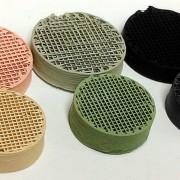Filtering Out the Toxins From Bites, Stings and Bacteria With 3D Printed Nanotechnology
A team of nanoengineers at the University of California, San Diego have published their work on a 3D printed device which functions much like the human liver to remove dangerous toxins from the blood.
 Designed for use outside the body – essentially a dialysis machine – the device makes use of nanoparticles to trap ‘pore-forming’ toxins capable of damaging cellular membranes. The toxins are key factors in illnesses which result from animal bites, insect stings and bacterial infections.
Designed for use outside the body – essentially a dialysis machine – the device makes use of nanoparticles to trap ‘pore-forming’ toxins capable of damaging cellular membranes. The toxins are key factors in illnesses which result from animal bites, insect stings and bacterial infections.
These engineered nanoparticles have the ability to latch onto toxins. The problem comes when it’s time to evacuate them from the body undisturbed. These toxins have a tendency to accumulate inside the liver for hepatic metabolism and excretion, and that creates a risk of ‘secondary poisoning.’
Made of a hydrogel embedded with detoxifying nanoparticles, the UCSD investigators used polydiacetylene nanoparticles capable of trapping toxins inside the hydrogel matrix until the entire system is removed or disconnected.
To prove their device works, the team ran a solution of pore-forming toxins through the device, and the results showed that the virulence of the solution fell to zero following filtration.
“One unique feature of this device is that it turns red when the toxins are captured,” said Xin Qu, a postdoctoral researcher working in Shaochen Chen’s lab.
 Dr. Shaochen Chen is a Professor in the Nanoengineering Department and the Bioengineering Department at the University of California, San Diego, and he’s also the Founding Director of the Biomaterials and Tissue Engineering Center. A faculty member of the Institute of Engineering in Medicine and Clinical and Translational Research Institute at UC San Diego, Chen served as the Program Director for the Nanomanufacturing Program of the National Science Foundation.
Dr. Shaochen Chen is a Professor in the Nanoengineering Department and the Bioengineering Department at the University of California, San Diego, and he’s also the Founding Director of the Biomaterials and Tissue Engineering Center. A faculty member of the Institute of Engineering in Medicine and Clinical and Translational Research Institute at UC San Diego, Chen served as the Program Director for the Nanomanufacturing Program of the National Science Foundation.
Chen’s lab has already printed complex 3D microstructures, such as blood vessels, made from soft, biocompatible, hydrogels which contain living cells.
“The concept of using 3D printing to encapsulate functional nanoparticles in a biocompatible hydrogel is novel,” Chen says. “This will inspire many new designs for detoxification techniques since 3D printing allows user-specific or site-specific manufacturing of highly functional products.”

This latested biofabrication technology, called Dynamic Optical Projection Stereolithography, or DOPsL, produces the micro and nanoscale resolution required to print tissues made to mimic the fine details found in nature like blood vessels. Using a computer projection system tied in to precisely controlled micromirrors, the device shines light on a selected area of a solution containing photosensitive biopolymers and cells. The process forms a single layer of a solid structure at a time in a continuous series.
The technology is being developed with funds provided by a four -year, $1.5 million grant from the National Institutes of Health and is also supported in part by a grant from the National Science Foundation.
Source: 3d Printer World












Leave a Reply
Want to join the discussion?Feel free to contribute!